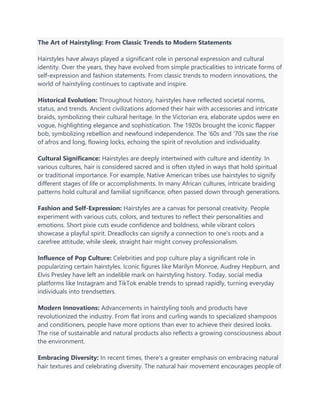The Art of Hairstyling: From Classic Trends to Modern Statements
Hairstyles have always played a significant role in personal expression and cultural identity. Over the years, they have evolved from simple practicalities to intricate forms of self-expression and fashion statements. From classic trends to modern innovations, the world of hairstyling continues to captivate and inspire. Historical Evolution: Throughout history, hairstyles have reflected societal norms, status, and trends. Ancient civilizations adorned their hair with accessories and intricate braids, symbolizing their cultural heritage. In the Victorian era, elaborate updos were en vogue, highlighting elegance and sophistication. The 1920s brought the iconic flapper bob, symbolizing rebellion and newfound independence. The '60s and '70s saw the rise of afros and long, flowing locks, echoing the spirit of revolution and individuality. Cultural Significance: Hairstyles are deeply intertwined with culture and identity. In various cultures, hair is considered sacred and is often styled in ways that hold spiritual or traditional importance. For example, Native American tribes use hairstyles to signify different stages of life or accomplishments. In many African cultures, intricate braiding patterns hold cultural and familial significance, often passed down through generations.

Recommended
Recommended
More Related Content
Similar to The Art of Hairstyling: From Classic Trends to Modern Statements
Similar to The Art of Hairstyling: From Classic Trends to Modern Statements (20)
Recently uploaded
Recently uploaded (11)
The Art of Hairstyling: From Classic Trends to Modern Statements
- 1. The Art of Hairstyling: From Classic Trends to Modern Statements Hairstyles have always played a significant role in personal expression and cultural identity. Over the years, they have evolved from simple practicalities to intricate forms of self-expression and fashion statements. From classic trends to modern innovations, the world of hairstyling continues to captivate and inspire. Historical Evolution: Throughout history, hairstyles have reflected societal norms, status, and trends. Ancient civilizations adorned their hair with accessories and intricate braids, symbolizing their cultural heritage. In the Victorian era, elaborate updos were en vogue, highlighting elegance and sophistication. The 1920s brought the iconic flapper bob, symbolizing rebellion and newfound independence. The '60s and '70s saw the rise of afros and long, flowing locks, echoing the spirit of revolution and individuality. Cultural Significance: Hairstyles are deeply intertwined with culture and identity. In various cultures, hair is considered sacred and is often styled in ways that hold spiritual or traditional importance. For example, Native American tribes use hairstyles to signify different stages of life or accomplishments. In many African cultures, intricate braiding patterns hold cultural and familial significance, often passed down through generations. Fashion and Self-Expression: Hairstyles are a canvas for personal creativity. People experiment with various cuts, colors, and textures to reflect their personalities and emotions. Short pixie cuts exude confidence and boldness, while vibrant colors showcase a playful spirit. Dreadlocks can signify a connection to one's roots and a carefree attitude, while sleek, straight hair might convey professionalism. Influence of Pop Culture: Celebrities and pop culture play a significant role in popularizing certain hairstyles. Iconic figures like Marilyn Monroe, Audrey Hepburn, and Elvis Presley have left an indelible mark on hairstyling history. Today, social media platforms like Instagram and TikTok enable trends to spread rapidly, turning everyday individuals into trendsetters. Modern Innovations: Advancements in hairstyling tools and products have revolutionized the industry. From flat irons and curling wands to specialized shampoos and conditioners, people have more options than ever to achieve their desired looks. The rise of sustainable and natural products also reflects a growing consciousness about the environment. Embracing Diversity: In recent times, there's a greater emphasis on embracing natural hair textures and celebrating diversity. The natural hair movement encourages people of
- 2. all ethnicities to embrace their natural curls, coils, and waves, promoting self-acceptance and challenging Eurocentric beauty standards. Conclusion: Hairstyling is far more than just a mundane routine – it's an art form, a cultural marker, and a form of self-expression. From historical symbolism to modern trends, our hairstyles speak volumes about who we are and how we want to be perceived. As we continue to evolve, our hair will undoubtedly remain a dynamic canvas for creativity and identity.